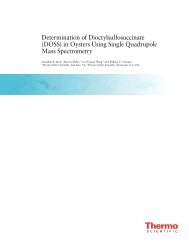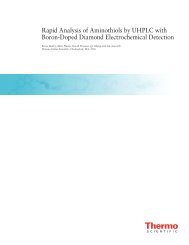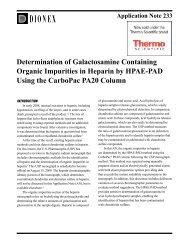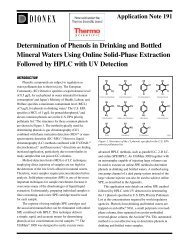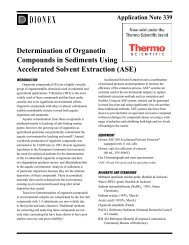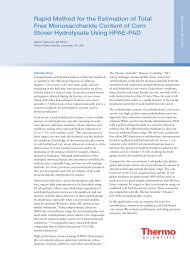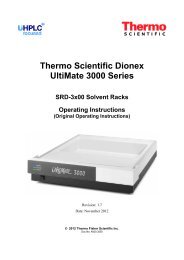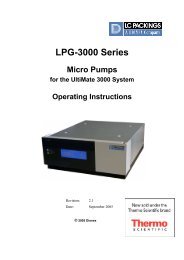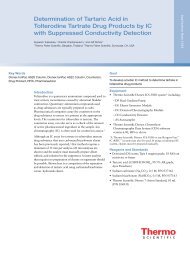Accelerated Solvent Extraction (ASE) and Productivity ... - Dionex
Accelerated Solvent Extraction (ASE) and Productivity ... - Dionex
Accelerated Solvent Extraction (ASE) and Productivity ... - Dionex
Create successful ePaper yourself
Turn your PDF publications into a flip-book with our unique Google optimized e-Paper software.
<strong>Accelerated</strong> <strong>Solvent</strong> <strong>Extraction</strong> (<strong>ASE</strong>) <strong>and</strong><br />
<strong>Productivity</strong> Gains in Environmental Analyses<br />
Bruce Richter1 , Sheldon Henderson1 , Eric Francis1 , Richard Carlson1 , Brett Murphy1 ,<br />
Brian Dorich1 , Jennifer Peterson1 , Kannan Srinivasan2 , <strong>and</strong> Rahmat Ullah2 Bruce Richter<br />
1<strong>Dionex</strong> Corporation, Salt Lake City Technical Center, Salt Lake City, Utah<br />
2<strong>Dionex</strong> Corporation, Sunnyvale, CA USA<br />
1 , Sheldon Henderson1 , Eric Francis1 , Richard Carlson1 , Brett Murphy1 ,<br />
Brian Dorich1 , Jennifer Peterson1 , Kannan Srinivasan2 , <strong>and</strong> Rahmat Ullah2 1<strong>Dionex</strong> Corporation, Salt Lake City Technical Center, Salt Lake City, Utah<br />
2<strong>Dionex</strong> Corporation, Sunnyvale, CA USA<br />
Current ASe ® ProduCt Line<br />
• <strong>ASE</strong> 200 introduced as an accelerated solvent extractor in 1995<br />
– Accommodates up to 24 cells ranging from 1 to 33 mL<br />
– Most popular <strong>ASE</strong> product<br />
• <strong>ASE</strong> 300 introduced in 2000<br />
– Accommodates up 12 cells ranging from 10 to 100 mL<br />
• <strong>ASE</strong> 100 introduced in 2002<br />
– Accommodates single sample ranging from 10 to 100 mL<br />
Figure 1. <strong>ASE</strong> 100, <strong>ASE</strong> 200, <strong>and</strong> <strong>ASE</strong> 300.<br />
Load Cell<br />
Fill with 0.5–1 min<br />
solvent<br />
Heat <strong>and</strong> 5 min<br />
pressurize<br />
Static 5 min<br />
<strong>Extraction</strong><br />
Flush with 0.5 min<br />
fresh solvent<br />
Purge with 1–2 min<br />
nitrogen<br />
Figure 2. <strong>ASE</strong> schematic<br />
Pittcon 2008 Presentation<br />
Cycle<br />
Extract Total<br />
ready 12–18 min<br />
<strong>Solvent</strong><br />
N2<br />
Nitrogen<br />
Pump<br />
Purge Valve<br />
Oven<br />
<strong>Extraction</strong><br />
Cell<br />
Static<br />
Valve<br />
Collection<br />
Vial<br />
17567-01<br />
Pittcon 2008 Presentation 1
ASe teChnoLogy<br />
• Patented flow-thru design that allows solvent control separately for<br />
each sample<br />
– In-line filtration<br />
– In-cell cleanup<br />
– Fractionation or selectivity<br />
• Control of temperature <strong>and</strong> pressure for each individual sample:<br />
– Requires small quantities of solvent <strong>and</strong> short periods of time<br />
– 50 mL vs. hundreds of mL<br />
– 15 min vs. several hours<br />
• Multiple cell sizes that support a wide range of sample sizes<br />
(1–100 g)<br />
• Platform for automation<br />
• Used by government agencies <strong>and</strong> laboratories worldwide<br />
ASe StAndArd MethodS uPdAte<br />
• US EPA Method 3545A<br />
– OCP, OPP, BNA, TPH, PCDD, herbicides <strong>and</strong> semivolatiles<br />
– No other vendor has submitted data demonstrating validity<br />
• Accepted under CLP SOW OLM04.2 (Contract Laboratory Program<br />
Statement of Work)<br />
• Chinese Method GB/T 19649–2005 for 405 pesticides in grains <strong>and</strong><br />
grain products<br />
• German Method L00.00–34 for pesticides in foodstuffs<br />
• ASTM St<strong>and</strong>ard Practice D 7210 for additives in polymers<br />
• Other methods in various stages of approval globally<br />
– 16 environmental methods in China<br />
APPLiCAtionS<br />
Environmental Applications<br />
• US EPA method 3545A<br />
– Pesticides <strong>and</strong> herbicides<br />
– PAHs <strong>and</strong> semi-volatiles<br />
– PCBs<br />
– Dioxins <strong>and</strong> furans<br />
– TPH (Total Petroleum<br />
Hydrocarbons)<br />
– Explosives<br />
• Air samples<br />
– PUF (polyurethane foam) cartridges<br />
– Quartz filters<br />
– XAD <strong>and</strong> charcoal<br />
• PBDEs in flora, fauna, sediments <strong>and</strong> soils<br />
• Method 6860<br />
– Perchlorate in soils, plants <strong>and</strong> animal tissues<br />
• Organo-mercury, arsenic, tin <strong>and</strong> selenium<br />
Figure 3. Schematic of selective extraction using <strong>ASE</strong>.<br />
2 <strong>Accelerated</strong> <strong>Solvent</strong> <strong>Extraction</strong> (<strong>ASE</strong>) <strong>and</strong> <strong>Productivity</strong> Gains in Environmental Analyses<br />
<strong>Extraction</strong><br />
Sample plus<br />
dispersant<br />
In cell absorbents to<br />
reduce interferences<br />
(alumina, silica, etc.)<br />
22854
PCBs in Animal Tissues<br />
One-Step Selective <strong>Extraction</strong><br />
• Egg, oyster, clam, fish, <strong>and</strong> mussel samples collected, freeze-dried,<br />
<strong>and</strong> ground<br />
• 2 g samples mixed with Florisil, placed on 6 g of Florisil in extraction<br />
cell (use of in-cell absorbents)<br />
• DCM/pentane (15:85, v/v) at 40 °C<br />
• 1500 psi (10.34 MPa)<br />
• 25-min extraction, 40 mL of solvent<br />
• GC with ECD for analysis<br />
Gomez-Ariza, J. L., et al., J. Chromatogr. A, 2002, 946, 209–219.<br />
PCBs in Animal Tissues: Selective <strong>Extraction</strong><br />
• Lipid content of samples ranged from 2.9 to 10.2% by weight<br />
• 85–120% recovery as compared to Soxhlet<br />
• Less than 0.1% of the lipids in<br />
sample were collected in vials<br />
because of selective extraction<br />
• MDLs of 0.001 to 0.004 ng/g<br />
• Less than 11% RSD<br />
Integrated Clean-Up: Salmon Extracts<br />
Figure 4. Extracts with <strong>and</strong> without in-cell clean-up<br />
of fish tissue using alumina, silica gel, <strong>and</strong> acidic<br />
silica gel (40% H 2 SO 4 ).<br />
Clx Clx<br />
• Analyzed by Agilent Tech., (GC) 6890N, with a GCMate II (MS), ionization<br />
mode, electron-capture negative ionization (ECNI), monitoring<br />
bromines (79 <strong>and</strong> 81 m/z).<br />
• DB5-HT column (30m)<br />
• Top chromatogram is calibration check<br />
• Second chromatogram is the salmon sample extract with in cell<br />
clean-up<br />
Data courtesy of Mark LaGuardia of VIMS<br />
Figure 5. <strong>ASE</strong> PBDE results.<br />
Pittcon 2008 Presentation 3
introduCing the new ASe 150 And 350<br />
<strong>ASE</strong> 150<br />
• Improved <strong>and</strong> repackaged <strong>ASE</strong> 100<br />
• Faster pump (70 mL/min vs. 35 mL/min)<br />
• Accepts both sizes of collection bottles (60- <strong>and</strong> 250-mL)<br />
• New pneumatics use less compressed gas<br />
• New oven block design for improved heating<br />
• pH hardened pathway with Dionium components<br />
– Optional Dionium cells<br />
– Adsorbent or resin mixed with samples to<br />
neutralize acid<br />
• Accommodates all cell sizes (1, 5, 10, 22, 34, 66, <strong>and</strong> 100 mL)<br />
• New industrial design: new colors <strong>and</strong> outside design; safety shields<br />
Figure 6. <strong>ASE</strong> 150.<br />
4 <strong>Accelerated</strong> <strong>Solvent</strong> <strong>Extraction</strong> (<strong>ASE</strong>) <strong>and</strong> <strong>Productivity</strong> Gains in Environmental Analyses<br />
<strong>ASE</strong> 350: the New St<strong>and</strong>ard<br />
• New pump, oven block, pneumatics, safety shield, etc.<br />
• Combination of <strong>ASE</strong> 200 <strong>and</strong> 300 capabilities<br />
– 24 smaller cells (1, 5, 10, 22, or 34 mL)<br />
– 19 larger cells (66 or 100 mL)<br />
– 19 smaller cells <strong>and</strong> 5 larger cells<br />
– 60- or 250-mL collection bottles (up to 28 small <strong>and</strong> 5 large)<br />
• New colors <strong>and</strong> industrial design<br />
• pH hardened pathway with Dionium components<br />
– Optional Dionium cells<br />
– Adsorbent or resin mixed with samples to neutralize acid<br />
• Integrated <strong>Solvent</strong> Controller<br />
• New mode of operation—<strong>Solvent</strong> Saver Mode<br />
• USB port for firmware update <strong>and</strong> computer connection<br />
– Chromeleon ® control not available at introduction<br />
Figure 7. <strong>ASE</strong> 350.
Figure 8. <strong>ASE</strong> 350 (blue) <strong>and</strong> <strong>ASE</strong> 300 with solvent controller (orange). Smaller<br />
overall footprint; less total bench space required<br />
innovAtion in teChnoLogy<br />
pH-Hardened pathway<br />
• Resistant to acids <strong>and</strong> bases<br />
– 0.1 M HCl, H SO , NaOH, KOH<br />
2 4<br />
– Cannot pump strong acids or bases<br />
– Can perform acidic or alkaline<br />
pretreatments<br />
• Inert cells with Dionium<br />
– Stainless steel st<strong>and</strong>ard<br />
• Acidic adsorbents can be better utilized for<br />
selective extractions<br />
<strong>Solvent</strong><br />
Pretreated<br />
Matrix<br />
In-cell<br />
Clean-up<br />
Relief Valve<br />
<strong>Solvent</strong> <strong>Solvent</strong><br />
Mixing Valve<br />
Figure 9. 66-mL<br />
Dionium cell body.<br />
Figure 10. New <strong>ASE</strong> Schematic. Inherently the same <strong>ASE</strong>, accepted under st<strong>and</strong>ard<br />
methods, but you can do more!<br />
Pump<br />
N 2<br />
Chemistry<br />
<strong>Solvent</strong> extraction<br />
Static Valve<br />
Collection Bottle<br />
new APPLiCAtionS with new<br />
ASe ProduCtS<br />
• Environmental<br />
– Acid pretreatment for improved recoveries of phenols,<br />
herbicides, etc.<br />
– Improved in cell clean-up for dioxins, PCBs, etc.<br />
– Oil <strong>and</strong> grease after acidification<br />
– High pH extraction of Cr (VI)<br />
• Bio/Pharma<br />
– Drugs <strong>and</strong> metabolites from animal tissue after pH adjustment<br />
– Pretreatment of capsules or tablets for potency testing<br />
– Natural products after pH adjustment<br />
• Food <strong>and</strong> Beverage<br />
– Lipid content after acid hydrolysis or base saponification<br />
• Chem/Petrochem<br />
– Biomass after acidic treatments—ethanol production<br />
– Lipid content in bio-diesel processes<br />
SuMMAry<br />
New <strong>ASE</strong> 150 <strong>and</strong> 350<br />
Same Advantages as with Current <strong>ASE</strong><br />
• Save Time<br />
– Fast extraction <strong>and</strong> walk-away automation provides greater<br />
throughput than other techniques<br />
• Save <strong>Solvent</strong>s<br />
– Reduced solvent consumption using st<strong>and</strong>ard <strong>ASE</strong> operation or<br />
<strong>Solvent</strong> Saver Mode<br />
• Save Labor<br />
– Integrated steps save chemists <strong>and</strong> technicians sample<br />
h<strong>and</strong>ling time<br />
Additional Advantages of New <strong>ASE</strong> 150 <strong>and</strong> 350<br />
• Increased Capability<br />
– pH hardened flow path allows for extraction of acidic or<br />
basic matrices for new applications<br />
• Increased <strong>Productivity</strong><br />
– Combining pretreatment, extraction <strong>and</strong> cleanup all in one step<br />
• Increased Flexibility<br />
– New modes of operation<br />
– New absorbent<br />
• Increased Value<br />
– Built-in <strong>Solvent</strong> Controller<br />
– Different sample sizes on same instrument<br />
Pittcon 2008 Presentation 5
Passion. Power. <strong>Productivity</strong>.<br />
dionex Corporation<br />
1228 Titan Way<br />
P.O. Box 3603<br />
Sunnyvale, CA<br />
94088-3603<br />
(408) 737-0700<br />
north America<br />
U.S. (847) 295-7500<br />
Canada (905) 844-9650<br />
South America<br />
Brazil (55) 11 3731 5140<br />
europe<br />
Austria (43) 1 616 51 25 Benelux (31) 20 683 9768; (32) 3 353 4294<br />
Denmark (45) 36 36 90 90 France (33) 1 39 30 01 10 Germany (49) 6126 991 0<br />
Irel<strong>and</strong> (353) 1 644 0064 Italy (39) 02 51 62 1267 Switzerl<strong>and</strong> (41) 62 205 9966<br />
United Kingdom (44) 1276 691722<br />
Dionium is a trademark <strong>and</strong> <strong>ASE</strong> <strong>and</strong> Chromeleon are registered trademarks of <strong>Dionex</strong> Corporation.<br />
Asia Pacific<br />
Australia (61) 2 9420 5233 China (852) 2428 3282 India (91) 22 2764 2735<br />
Japan (81) 6 6885 1213 Korea (82) 2 2653 2580 Singapore (65) 6289 1190<br />
Taiwan (886) 2 8751 6655<br />
www.dionex.com<br />
LPN 2018-01 3/08<br />
©2008 <strong>Dionex</strong> Corporation




